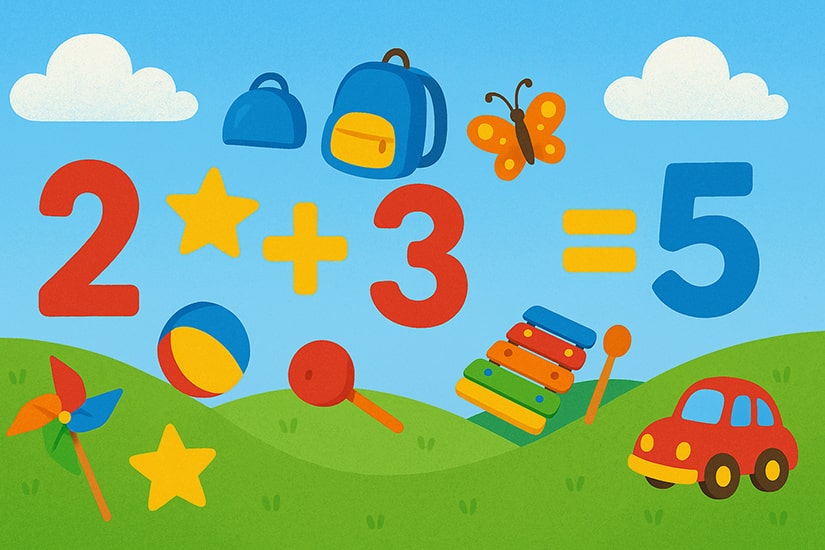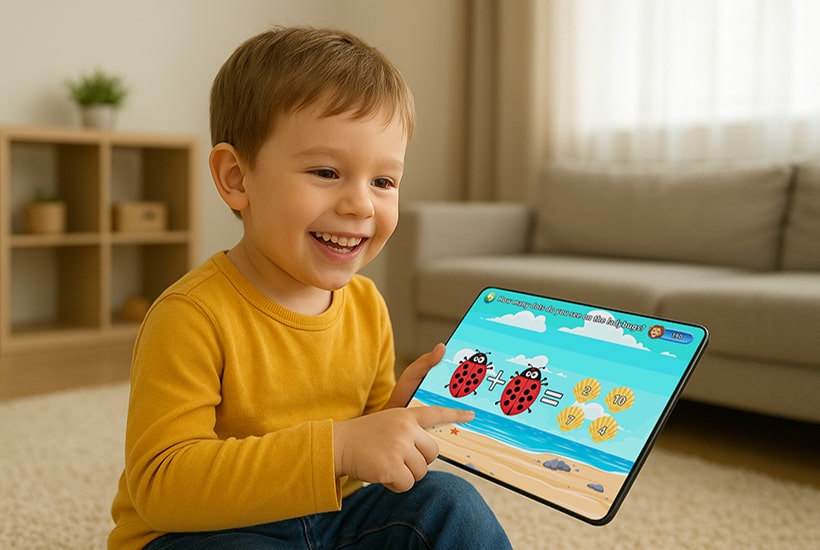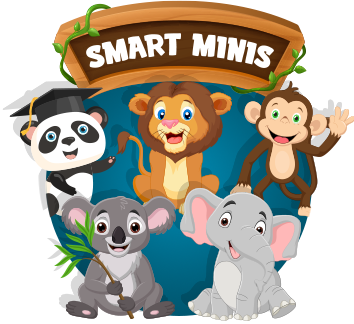Table of contents
How learning apps support alphabet, language & math skills
Alphabet & Early Literacy Skills
Learning apps can provide rich, engaging opportunities for young children to interact with letters, sounds, word recognition and early reading. With animations, touch interactions, phonics games and immediate feedback, kids can practise letter names and sounds in a low-pressure setting.
Research shows that children can make measurable gains in literacy competencies when given access to focused digital tools. For example, a study found that high-quality home-based learning apps improved literacy and math skills for children around age 5.
Language & Vocabulary Development
Apps often include interactive storytelling, vocabulary games, drag-and-drop word matching, and sentence building, all of which support language development.
Because language underpins children’s ability to learn in other domains, apps that build vocabulary and comprehension can accelerate overall learning. They provide opportunities for repeated exposure to new words and concepts, in a dynamic medium.
One review reports that interactive app use in children under 6 shows evidence of benefit for early academic skills, especially when designed well.
“Compared with two control groups with and without tablets, children in the intervention groups significantly enhanced their specific competencies. Consequently, an easy-to-apply app-based intervention supports children’s development of cognitive competencies and helps prepare them for school.”
National Library of Medicine
Early Math Skills
Learning apps are particularly effective when supporting early math skills: number sense, counting, comparing quantities, patterns, shapes and spatial reasoning.
One large-scale study of an app intervention found statistically significant gains in children’s math competencies when they used learning apps.
Apps can adaptively present challenges, reward progress, and provide visual/spatial models of mathematical concepts that are hard to capture with traditional worksheets.



Key advantages of learning apps for ages 2–7
Engagement and motivation
Young children are naturally drawn to screens, movement, colorful graphics and interactive touches. Learning apps can harness that interest to make practice more fun. When children engage willingly, the amount of time spent practising letters, words or math concepts can increase, leading to faster learning. Study reviews show that interactive apps show promise for improving early academic skills.
Frequent, short sessions
Apps let children practice in short, manageable sessions, ideal for younger learners with shorter attention spans. Regular, spaced practice is more effective than infrequent long sessions. Because apps are portable and accessible at home, extra micro-sessions can add up.
Immediate feedback & reinforcement
Many apps provide immediate feedback when a child taps a correct or incorrect answer, gives hints, or celebrates success. This reinforcement supports learning and helps children correct mistakes early. Digital environments can integrate feedback loops more smoothly than paper tasks.
Home-school connection & accessibility
Learning apps can be used at home, complementing homeschool or preschool activity. Especially for children who may lack access to high-quality preschool programs, apps can help narrow early learning gaps. For example, in one study of ~14,000 children ages 2–8 using an educational app over a summer, children with lower starting skills caught up significantly compared to peers.

The game shown is from the educational app Smart Minis
Important caveats & what research says
Screen time concerns & balance
Using apps replaces other activities (like hands-on play, social interaction, outdoor activity). Screen time guidelines still apply.
It’s important to balance app use with real-world interaction, reading aloud, and unstructured play. Additionally, one study emphasises careful choice of apps: heavy use of ads or inappropriate design features can counteract benefits.
Security, suitability & parental involvement matter
Research evaluating early childhood apps found that many lacked sufficient parental control, security and did not align with best practices for learning.
Effective use means parents/educators engage with the app environment, choose apps thoughtfully, and complement it with real-world talk and activities.
Quality varies, not all apps are created equal
While many learning apps offer promise, research warns that many popular apps do not incorporate evidence-based design for young children. For example, a study found that more than half of the preschool math & literacy apps lacked age-appropriate teaching features. The practical upshot: just handing a child any “educational” app won’t guarantee faster learning.
When choosing a learning app for your child, try it out yourself first to see if it offers enough engaging content. Think about whether you’d like your child to learn new words, explore early math challenges, or do both in one app, there are great options for every goal.
While educational value is important, the app also needs to entertain and reward your child for completing challenges. Without those fun elements, kids can quickly lose interest, so look for an app that makes learning feel like play.


Practical tips: How to choose & use learning apps effectively
How to choose a quality learning app
Look for apps that focus on active learning, not just flashy animations or passive tapping. As one guide notes, good apps require children to think and engage, rather than just reacting.
Check that the app aligns with key early learning domains: alphabet/phonics, vocabulary/language, number sense, and shapes/colors.
Choose apps that have no ads, good parental controls, and clear age-appropriateness.
Research shows that 90% of children between the ages of 2 and 3 use touchscreen devices.
Psychology Today
How to use learning apps in a way that accelerates learning
Integrate app sessions with adult or parent interaction. Even the best educational apps are more effective when children talk about what they’re doing, apply what they learn in real life, and have a parent or educator observing and joining in.
Use apps for short, regular sessions rather than long marathons, for young children, about 10 to 15 minutes per session a few times a week is often ideal.
Pair app time with real-world activities to reinforce learning. For example, after an alphabet app session, go on a “letter hunt” around the house, or after a number game, count everyday objects together.
Monitor your child’s usage and progress to ensure they’re advancing and exploring a variety of content, such as letters, words, math, and games.

Balance digital learning with hands-on play, reading, outdoor exploration, and social interaction, the strongest learning happens when digital experiences connect to the real world.
Finally, set clear boundaries and routines for app use, making sure it never replaces sleep, outdoor play, or quality reading time.
Targeted suggestions for ages 2–7
Ages 2–4: Focus on very simple apps that introduce letters, sounds, basic words, shape recognition, counting to 10. Look for playful, colorful and varied apps that can be played in short sessions.
Ages 5–7: Choose apps that reinforce phonics, reading readiness, vocabulary, simple addition/subtraction, pattern recognition, spatial reasoning. Use apps as one part of a broader literacy and math routine.


Conclusion
Learning apps offer a powerful tool to help children ages 2 to 7 learn faster, particularly when it comes to literacy (letters, words), language/vocabulary and early math skills.
They bring benefits like personalized pacing, motivational game-like formats, frequent short practice sessions, and at-home access.
Research supports the promise: studies show children using high-quality apps can make measurable gains in literacy and math.
However, the difference between an effective app and one that simply entertains is important to consider when you look for a well-versed educational app for your child.
Used appropriately, learning apps can complement traditional reading, play, and instruction, and help give children an early edge in building foundational skills before they start school.
For parents, educators and caregivers: choose thoughtfully, use the app regularly but in balanced fashion, and always pair digital learning with real-life interaction and conversation.
In doing so, you unlock the full potential of technology as a partner in early childhood learning.






